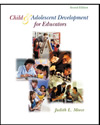 |  Child and Adolescent Development for Educators, 2/e Judith Meece,
University of North Carolina - Chapel Hill
Student Study Guide by Nancy Defrates-Densch
Self-Concept, Identity, and Motivation
Learning ObjectivesAfter studying this chapter, you should be able to:
| Describe Erikson's stages of psychosocial development and identify the developmental issue at each stage. |
 |  |  | | Discuss characteristics of children who are securely and insecurely attached, describe caregiver behaviors associated with secure and insecure attachment, and identify developmental outcomes for children who are securely attached and children who are insecurely attached. |
 |  |  | | Describe the development of children's ability to understand and express emotions from infancy through adolescence, and explain how teachers can foster the development of emotional competence in the classroom. |
 |  |  | | Distinguish between self-concept and self-esteem, describe developmental changes in children's self-concepts and self-esteem, and discuss ways teachers and schools can promote positive self-esteem. |
 |  |  | | Identify four identity statuses and describe what characterizes each. |
 |  |  | | Explain the development of ethnic identity and describe four different patterns of ethnic identity formation. |
 |  |  | | Describe developmental trends in gender-role conceptions; describe the process of gender-role socialization, and identify gender differences in self-perceptions. |
 |  |  | | Explain achievement motivation from the perspectives of motivation as a psychological need and motivation as a situational state, and describe cognitive theories of achievement motivation. |
 |  |  | | Explain how conceptions of ability, early learning experiences, parenting practices, gender, racial and ethnic background, and socioeconomic status may influence achievement motivation. |
|



 2002 McGraw-Hill Higher Education
2002 McGraw-Hill Higher Education